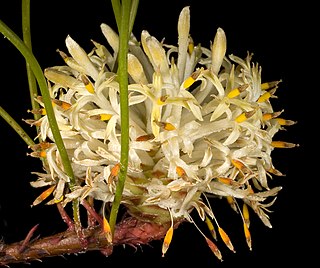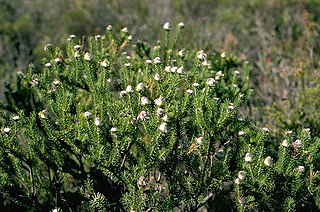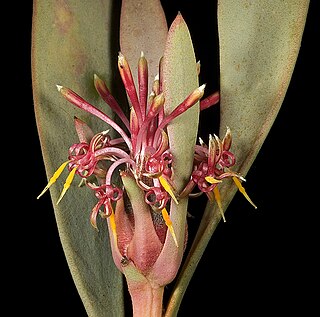
Isopogon sphaerocephalus, commonly known as drumstick isopogon or Lesueur isopogon, is a species of plant in the family Proteaceae and is endemic to the south-west of Western Australia. It is a shrub with linear to narrow egg-shaped leaves and spherical heads of hairy white to creamy yellow flowers.

Petrophile acicularis is a species of flowering plant in the family Proteaceae and is endemic to the south-west of Western Australia. It is a low, tufted shrub with cylindrical leaves and oval heads of densely hairy, cream-coloured flowers.

Petrophile antecedens is a species of flowering plant in the family Proteaceae and is endemic to the south-west of Western Australia. It is a small, erect, open shrub with sharply-pointed, cylindrical leaves and spherical heads of hairy, pale cream-coloured flowers.

Petrophile axillaris is a species of flowering plant in the family Proteaceae and is endemic to the south-west of Western Australia. It is a shrub with pinnately-divided, sharply-pointed leaves, and spherical heads of hairy pink or grey flowers.

Petrophile brevifolia is a species of flowering plant in the family Proteaceae and is endemic to the south-west of Western Australia. It is a shrub with cylindrical, sharply-pointed leaves, and spherical heads of hairy yellow, cream-coloured or white flowers.
Petrophile clavata is a species of flowering plant in the family Proteaceae and is endemic to the south-west of Western Australia. It is a shrub with curved, needle-shaped, sharply-pointed leaves and spherical heads of hairy, cream-coloured to very pale yellow flowers.

Petrophile conifera is a species of flowering plant in the family Proteaceae and is endemic to the south-west of Western Australia. It is a bushy, much-branched shrub with pinnate, sharply-pointed leaves, and oval heads of hairy, cream-coloured to yellowish white flowers.

Petrophile filifolia is a species of flowering plant in the family Proteaceae and is endemic to southwestern Western Australia. It is a small shrub with curved, long, needle-shaped leaves and more or less spherical heads of hairy cream-coloured to pale yellow flowers.

Petrophile megalostegia is a species of flowering plant in the family Proteaceae and is endemic to southwestern Western Australia. It is a shrub with needle-shaped or flattened, sometimes S-shaped leaves with a sharply-pointed tip, and more or less cylindrical heads of silky-hairy, yellow to cream-coloured flowers.
Petrophile nivea is a species of flowering plant in the family Proteaceae and is endemic to southwestern Western Australia. It is a small shrub with crowded cylindrical, sharply-pointed leaves and more or less spherical heads of hairy white or cream-coloured flowers on the ends of branchlets.
Petrophile pilostyla is a species of flowering plant in the family Proteaceae and is endemic to southwestern Western Australia. It is a shrub with needle-shaped, sharply-pointed leaves and spherical heads of hairy, cream-coloured or pale yellow flowers.

Petrophile prostrata is a species of flowering plant in the family Proteaceae and is endemic to southwestern Western Australia. It is a prostrate shrub with needle-shaped but usually not sharply-pointed leaves and spherical heads of hairy, pale yellow or cream-coloured flowers.

Petrophile recurva is a species of flowering plant in the family Proteaceae and is endemic to south-western Western Australia. It is an erect, many-branched shrub with needle-shaped, sharply-pointed leaves, and spherical heads of hairy pale yellow or cream-coloured flowers.

Petrophile scabriuscula is a species of flowering plant in the family Proteaceae and is endemic to southwestern Western Australia. It is a dense, prickly shrub with sharply-pointed, needle-shaped leaves more or less pressed against the branchlets, and oval heads of hairy, yellow to creamy-yellow flowers.

Petrophile semifurcata is a species of flowering plant in the family Proteaceae and is endemic to an area near the west coast of Western Australia. It is an erect, bushy shrub with sharply-pointed, needle-shaped, sometimes lobed leaves and oval heads of silky-hairy, whitish, lemon-yellow or cream-coloured flowers.

Petrophile trifurcata is a species of flowering plant in the family Proteaceae and is endemic to the south-west of Western Australia. It is a shrub with three-lobed, needle-shaped, sharply-pointed leaves, and spherical heads of hairy, yellow flowers.

Isopogon pruinosus is a species of flowering plant in the family Proteaceae and is endemic to southwestern Western Australia. It is a compact, spreading shrub with narrow egg-shaped leaves with the narrower end towards the base and spherical to elliptic heads of pink flowers.

Isopogon heterophyllus is a plant in the family Proteaceae and is endemic to the southwest of Western Australia. It is a shrub with simple or pinnate, cylindrical leaves and hairy, usually pink flowers.
Petrophile globifera is a species of flowering plant in the family Proteaceae and is endemic to southwestern Western Australia. It is a shrub with more or less cylindrical leaves and elliptic to spherical heads of cream-coloured to pale yellow flowers on the ends of branchlets.
Petrophile septemfida is a species of flowering plant in the family Proteaceae and is endemic to southwestern Western Australia. It is a shrub with leaves usually with seven lobes divided almost to the midrid, and spherical heads of cream-coloured to pale yellow flowers on the ends of branchlets.














